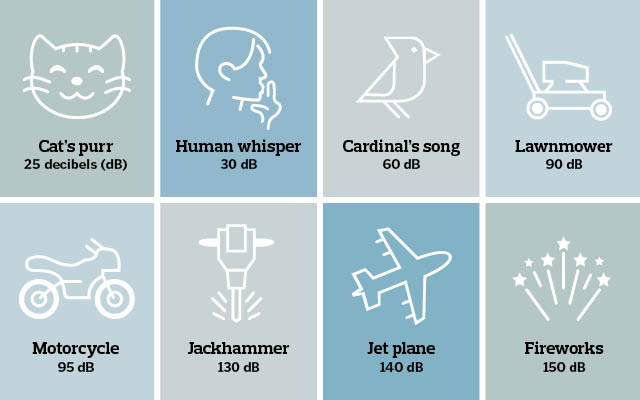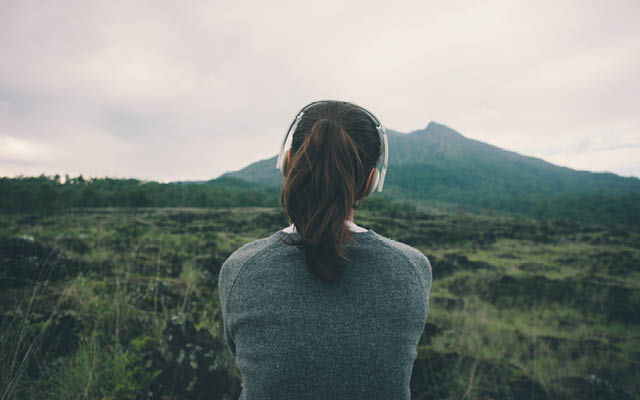Many people noticed a startling sound in the early months of the coronavirus pandemic: Amid the silence left in the wake of grounded airplanes and reduced road traffic came a melody from the trees — birdsong.
Depending on where you were, you may have heard cardinals or morning doves, meadowlarks, owls, even eagles — sounds often drowned out by humans’ ambient noise pollution.
“Song is what the world does. From the tiniest bugs sitting on branches to birds and frogs and whales, the planet is singing,” says Cornell University bioacoustics expert Christopher Clark, PhD. But our noisy interruption “is so atrocious in their habitats that they can’t hear each other up to half the time.”
Birds’ lives can be disrupted by our noise, which can interfere with their communication, breeding, migration navigation, and predator detection. And in a sad swan song, it may even threaten their existence.
Humans are loud. A thunderclap may measure 120 decibels, but we regularly outdo that. Subway trains rocket by at 115 decibels, rock concerts roll out 120, and both gunshots and police sirens can top 140. And those are just the most-heard noises.
There’s also oil drilling and fracking, military explosions, and seismic testing. Sounds above 80 decibels can be hazardous to humans, according to the World Health Organization (WHO) — and the animal world has much more acute hearing.
England’s Royal Society — the famous college of natural philosophers, founded in 1660 — declared noise a “major global pollutant” in 2019. The WHO states that noise is one of the most hazardous forms of pollution and has become omnipresent.
And things are not quieting down: We’re constantly dialing the volume up.
An Invisible Threat
Our noise is everywhere. Sound pollution is invading the natural environment, from deserts to mountain ranges — it’s even reverberating under the polar ice caps, which in the past provided a noise-free sanctuary to marine animals.
Biologists have long known that many animals rely on subtle sounds for communication, mating, and navigation. Recent studies have found that loud noises cause caterpillars’ hearts to beat faster and bluebirds to brood fewer chicks; human noise pollution obscures bats’ hunting sonar and scares and stresses elephants. We’re even upsetting the happy lives and livelihoods of clams.
Noise pollution also affects plants and trees. By scaring off pollinators and other animals that eat and disperse seeds, sound interrupts the propagation of vegetation.
The latest research finds that our amped-up noise is an ever-increasing concern for oceanic animals. The undersea throb of ship propellers, offshore oil drilling, and sonar devices is making the marine environment noisier and more chaotic.
And then there are seismic air-gun blasts, which are used to seek hidden oil and gas reserves and can reach more than 260 decibels. Plankton — a food source for animals from shrimp to whales — can be decimated up to three-quarters of a mile away from a single seismic test.
Noise pollution is particularly threatening to whales and dolphins, who use echolocation to communicate, navigate, and find food and mates. Naval sonar works similar to echolocation, sending sound waves as loud as 235 decibels hundreds of miles underwater.
Marine biologists find that sonar can disturb the feeding behavior of endangered blue whales and confuse giant squids’ sense of navigation, resulting in mass strandings on beaches.
“We are injecting so much noise that we are effectively acoustically bleaching the world’s oceans,” warns Clark.
Aural Litter
Our noise is also harming us. The WHO warns that “noise is the second-largest environmental cause of health problems, just after the impact of air pollution.”
WHO scientists call sound an “underestimated threat” that can cause numerous short- and long-term health problems. By far the most common are hearing loss and tinnitus, which can result from a single loud sound near your ear or from everyday noises that you are repeatedly exposed to over time.
Other problems include difficulty sleeping, cardiovascular stresses, and emotional and behavioral issues, such as annoyance, anger, and anxiety.
Recent UCLA research finds chronic noise associated with quicker cognitive decline in adults. Another study discovered that children living on the lower, noisier floors of city apartment buildings had a hard time distinguishing similar words, such as “thick” and “sick,” and more difficulty reading than kids who lived on higher floors.
And then there are the mental-health issues. Scientists studying people living near major airports found even a minor, 10-decibel increase in aircraft noise was associated with a 28 percent increase in anxiety-medication use.
Other research showed that people living in neighborhoods with louder traffic noise were 25 percent more likely than those living in quieter surroundings to display depression symptoms.
Preliminary reports also suggest noise pollution may lead to human-reproductive issues. Sonic stress may contribute to reduced male sperm count and lower-birth-weight infants, according to a meta-review of studies in the International Journal of Environmental Research and Public Health.
Finally, a 2019 WHO study reports that noise pollution in major cities has increased to such levels that it can cost residents three healthy years of their lives.
“We’re littering all over our soundscape,” warns Les Blomberg, founder and executive director of the Noise Pollution Clearinghouse. “It’s aural litter — acoustical trash — and, if you could see what you hear, it would look like piles and piles of McDonald’s wrappers, just thrown out the window as we go driving down the road.”
Yet we don’t have to resign ourselves to this accumulation — we can all be part of the noise-pollution solution. Find some opportunities for taking action at right.
Turn Down the Volume
“Increasing peace and quiet takes a community,” says Les Blomberg of the Noise Pollution Clearinghouse. “Individual efforts to quiet noise are great, but unfortunately, it only takes one noise maker to trump quiet. Therefore, peace and quiet requires a community effort. We need community expectations of quiet, and community regulations for when noise polluters violate those community expectations.”
Consider these ideas for dampening noise pollution where you live.
Minimize the sound you can control. Turn down TVs, computer games, fans, AC, and other noise-making gear. Music can be noisy too, whether it’s recorded music from a stereo system or homemade via an electric guitar or other instruments.
Research before you buy. Seek out reviews rating the noise levels made by household appliances, shop tools, lawn-maintenance equipment, and vehicles. Some are dramatically louder than others. Start a petition in your community asking local government to require and enforce noise-emission limits.
Protect everyone’s hearing. If you need hearing protection when lawnmowing, snowblowing, leaf-blowing, or chainsawing, it’s probably bothering others, too, including neighbors and animals. Consider electric-equipment options when available — and don’t start working before your neighbors wake up in the morning. “So much of noise pollution comes down to how we treat our neighbors. Good neighbors keep their noise to themselves,” says Blomberg.
Plant a tree. Vegetation from trees, shrubs, and bushes reduces sound intensity, helping to diffuse noise.
Become a noise-pollution fighter. Work with your local government to establish enforceable noise limits for your community and beyond. For more resources, see the EPA’s website or find your state agency.|
Decibel Chart of Common Sounds

This article originally appeared as “Sound Effect” in the March 2021 issue of Experience Life.




This Post Has 0 Comments